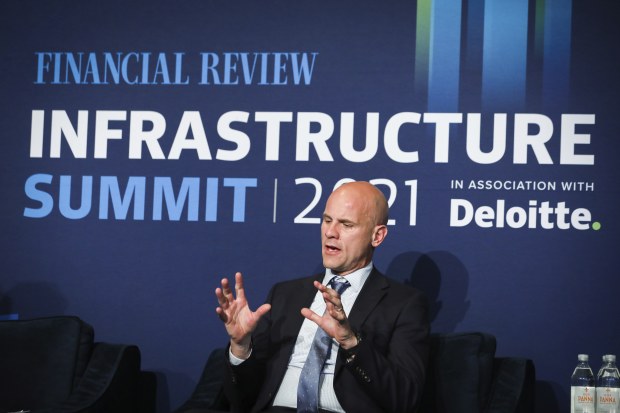Denver-based Vantage Data Centres is a big player globally with 30 “campuses” in 18 markets. It has big plans to grow and is capital-hungry – developing data centres is expensive.
So, Vantage was a logical target for AustralianSuper, the fast-growing industry fund with $300 billion in members’ money, inflows of about $20 billion a year, a big and now set infrastructure investment program, appetite for offshore investments and was scouring the market for telecommunications infrastructure.
Seeing the opportunity
Nik Kemp, who heads up AustralianSuper’s now $40 billion infrastructure portfolio, says the fund’s team in London got to know Vantage EMEA, which is its European arm, and its biggest shareholder, DigitalBridge, as it studied the global data centres scene for the past few years.
AustralianSuper could see Vantage EMEA had a big capital expenditure program coming, knew some of the existing investors (DigitalBridge and Canada’s PSP) may be set in their positions, and saw an opportunity.
The two parties talked turkey, Vantage EMEA went and tested the market, realised AustralianSuper was reasonably well advanced in its thinking and could cut a cheque relatively quickly, and the pair agreed on a deal.
AustralianSuper will invest $2.5 billion for a “significant minority” stake, which in the world of private capital usually means 20 to 40 per cent.
It’s a big cheque and one that would’ve been unfathomable only 10 years ago. Back then, AustralianSuper had $65 billion in assets, and about $5 billion in infrastructure, mostly in Australia and the majority of which was via capital committed to Melbourne fund manager IFM Investors.
Now, AustralianSuper is investing directly into infrastructure globally. Vantage EMEA will be a top-five asset in its infrastructure portfolio, Kemp said. Its other big bets include Sydney’s WestConnex and Brisbane’s Queensland Motorways (both alongside Transurban), a stake in the now privately owned Sydney Airport and a port in the UK.
It has about 15 per cent of its assets in infrastructure.
Nik Kemp heads up AustralianSuper’s infrastructure investment team, which has about a $40 billion portfolio to manage. Renee Nowytarger
The big direct investment push is paying dividends for now. However, it is too early to say whether it ends up being a winning strategy longer-term. AustralianSuper’s management is obviously confident it can mix it with the best managers globally.
There is a bit more risk attached to Vantage EMEA than taking a stake in Sydney Airport, NSW Ports (which owns Port Botany and Port Kembla) or NSW electricity poles and wires company Ausgrid. Vantage EMEA, just like Australian data centre groups, is a mix of greenfield developments and operating assets.
That higher risk means AustralianSuper is demanding a higher return – something “well into the teens” in terms of an internal rate of return, Kemp says.
That makes Vantage EMEA the sort of investment that could drive AustralianSuper’s long-term returns, rather than just parking cash in a safe and long-life infrastructure asset.
It also makes Vantage EMEA the sort of investment AustralianSuper needs if it is to stay ahead of its industry fund rivals, the bigger of which are also expanding investment teams offshore and investing directly into things like data centres.
Equities and bonds are the mainstays of their portfolios, but even a 10 or 15 per cent allocation to infrastructure means making big bets, and the sort of investments that are just too big to rely on solely using an external fund manager like IFM Investors. It’s the same in real estate.
AustralianSuper chief investment officer Mark Delaney likens it to wearing shorts.
“I like wearing shorts,” Delaney joked when handing down the fund’s profit result in early July. “But I can’t wear the same shorts I used to wear when I was 20.” In other words, it needs to keep adapting as its size grows.
He says AustralianSuper has gone from an external multi-manager model, to a hybrid of external managers and internal managers, and version three which is more internal and more international. All three versions can work, depending on the size of the portfolio.
AustralianSuper’s balanced fund returned 8.22 per cent in the year to June 30, which by pure coincidence was also in line with its three-year average. The big rally in Australian and international shares in the first six months of this calendar year was the biggest contributor.
One thing AustralianSuper will be wary of in making its latest infrastructure investment is its ESG credentials. Data centres are big power users, with vast amounts of electricity required to run them and keep them cool. Reliable power is the name of the game, and increasingly green power, which Kemp says is very much on his team’s and Vantage’s minds.
Source: afr.com

George Barham, an accomplished journalist and avid gambling enthusiast, serves as the esteemed Editor-in-Chief at fly-to-australia.com, Australia’s leading source for comprehensive gambling news and insights. With an unwavering passion for both the written word and the ever-evolving world of betting and gaming, George brings a wealth of knowledge and expertise to the helm of our editorial team.




